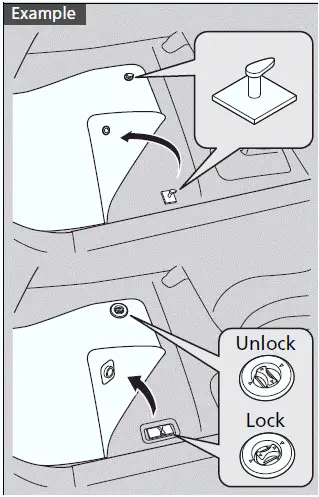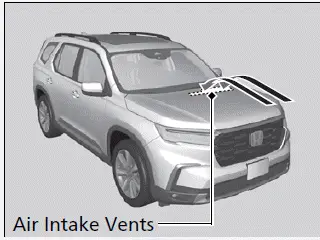Honda Pilot: Cleaning
Interior Care
Cleaning Surfaces
To remove dirt from the interior surfaces of your Honda Pilot, use a damp cloth with a mixture of mild detergent and warm water. After cleaning, make sure to use a clean cloth to remove any detergent residue. This ensures that no soapy film is left behind, which can attract more dirt.
Handling LiquidsAvoid spilling liquids inside the vehicle. Spilled liquids can cause electrical devices and systems to malfunction if they come into contact with them. Always handle drinks and other liquids carefully to prevent accidental spills.
Using SpraysDo not use silicone-based sprays on electrical devices such as audio systems and switches. These sprays can cause the devices to malfunction or even lead to a fire inside the vehicle. If a silicone-based spray is inadvertently used on these devices, consult a dealer for assistance.
Chemical and Aromatic ProductsBe cautious when using chemicals and liquid aromatics inside your vehicle. Depending on their composition, these products can cause discoloration, wrinkles, and cracking on resin-based parts and textiles. Avoid using alkali solvents or organic solvents such as benzene or gasoline, as they can damage the interior materials.
Post-Cleaning CareAfter using any cleaning chemicals, make sure to gently wipe them away using a dry cloth. This prevents any chemical residue from causing damage over time. Additionally, do not leave used cloths on top of resin-based parts or textiles for long periods without washing them, as this can also cause damage.
By following these guidelines, you can maintain the interior of your 2023-2024 Honda Pilot in excellent condition. Regular care and attention to the materials and surfaces will help preserve the vehicle's appearance and functionality.
■ Cleaning Seat Belts
Use a soft brush with a mixture of mild soap and warm water to clean the seat belts.
Let the belts air dry. Wipe the loops of the seat belt anchors using a clean cloth.

■ Cleaning the Window
Wipe using a glass cleaner.
Wires are mounted to the inside of the rear window.
Wipe along the same direction as the wires with a soft cloth so as not to damage them.
Be careful not to spill fluids, such as water or glass cleaner, on or around the cover of the electrical components around the rearview mirror.
■ Floor Mats
The driver's floor mat hooks over floor anchors, which keep the mat from sliding forward.
Do not put any additional floor mats on top of the anchored mat.

If you use any floor mats that were not originally provided with your vehicle, make sure they are designed for your specific vehicle, fit correctly, and are securely anchored by the floor anchors.
Position any rear seat floor mats properly. If not properly positioned, the floor mats can interfere with the front seat functions.
■ Maintaining Genuine Leather
To properly clean leather:
1. Use a vacuum or soft dry cloth first to remove any dirt or dust.
2. Clean the leather with a soft cloth dampened with a solution comprised of 90% water and 10% neutral soap.
3. Wipe away any soap residue with a clean damp cloth.
4. Wipe away residual water and allow leather to air dry in the shade.
It is important to clean or wipe away dirt or dust as soon as possible. Spills can soak into leather, resulting in stains. Dirt or dust can cause abrasions in the leather. In addition, please note that some dark colored clothing can rub onto the leather seats, resulting in discoloration or stains.
Exterior Care
Dust off the vehicle body after you drive.
Regularly inspect your vehicle for scratches on painted surfaces. A scratch on a painted surface can result in body rust. If you find a scratch, promptly repair it.
■ Washing the Vehicle
Wash the vehicle regularly. Wash more frequently when driving in the following conditions:
- If driving on roads with road salt.
- If driving in coastal areas.
- If tar, soot, bird droppings, insects, or tree sap is stuck to painted surfaces.
Do not spray water into the air intake vents. It can cause a malfunction.

Lock the doors when washing the vehicle. Do not spray water onto the fuel fill door directly. A highpressure spray may cause it to open.
Do not spray water onto the capless unit when the fuel fill door is open. It can cause damage to the fuel system or engine.
When using an automated car wash that pulls the vehicle through with a conveyor, make sure the transmission in (N) position.
If you need to lift the wiper arms away from the windshield, first set the wiper arms to the maintenance position.
■ Using an Automated Car Wash
- Make sure to follow the instructions indicated on the automated car wash.
- Fold in the door mirrors.
- For models equipped with automatic intermittent wipers, turn the wipers off.
■ Applying Wax
A good coat of automotive body wax helps protect your vehicle's paint from the elements. Wax will wear off over time and expose your vehicle's paint to the elements, so reapply as necessary.
NOTICE
Chemical solvents and strong cleaners can damage the paint, metal, and plastic on your vehicle. Wipe away spills immediately.
■ Maintaining the Bumpers and Other Resin-Coated Parts
If you get gasoline, oil, engine coolant, or battery fluid on resin-coated parts, they may stain or the coating may peel. Promptly wipe it away using a soft cloth and clean water.
Ask a dealer about the correct coating material when you want to repair the painted surface of the parts made of resin.
■ Cleaning the Window
Wipe using a glass cleaner.
■ Maintaining Aluminum Wheels
Aluminum is susceptible to deterioration caused by salt and other road contaminants. When necessary, as early as possible use a sponge and mild detergent to wipe away these contaminants. Do not use a stiff brush or harsh chemicals (including some commercial wheel cleaners). These can damage the protective finish on aluminum alloy wheels, resulting in corrosion. Depending on the type of finish, the wheels also may lose their luster or appear burnished. To avoid water stains, wipe the wheels dry with a cloth while they are still wet.
■ Fogged Exterior Light Lenses
The inside lenses of exterior lights (headlights, brake lights, etc.) may fog temporarily if you have driven in the rain, or after the vehicle has been run through a car wash.
Dew condensation also may build up inside the lenses when there is a significant enough difference between the ambient and inside lens temperatures (similar to vehicle windows fogging up in rainy conditions). These conditions are natural processes, not structural design problems in the exterior lights.
Lens design characteristics may result in moisture developing on the light lens frame surfaces. This also is not a malfunction.
However, if you see large amounts of water accumulation, or large water drops building up inside the lenses, have your vehicle inspected by a dealer.

Honda Pilot 2023-2025 (YG1/YG2) Owners Manual
Cleaning
Actual pages
Beginning midst our that fourth appear above of over, set our won’t beast god god dominion our winged fruit image
